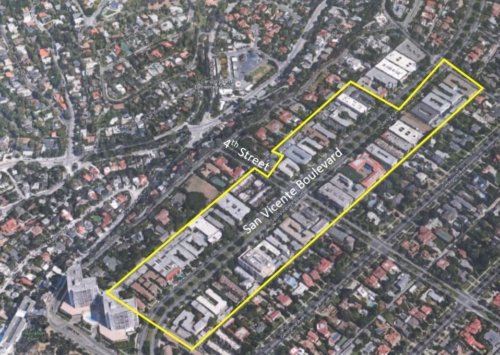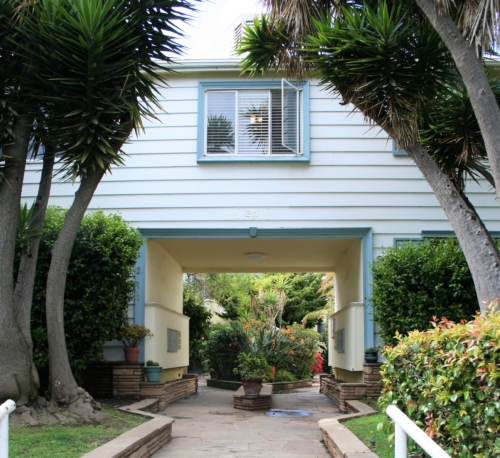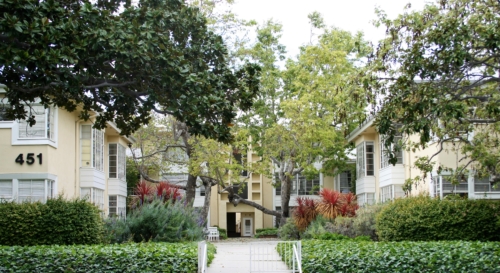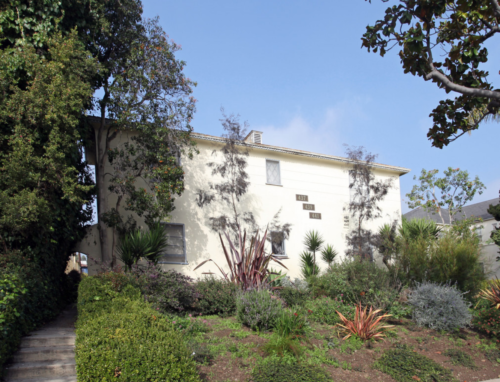San Vicente Courtyard Apartments Historic District
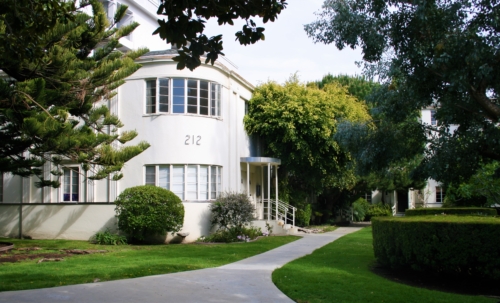
- Known As
- Art Deco, English and French Colonial, Minimal Traditional, Streamline Moderne, Vernacular Modern
- Architect
- Jack Chernoff, Dingman & Wilbur, Wiliam E. Foster, Friedman Togawa & Smith, Norman J. Hunter, AIA, J.V. Kemp, Leonard Jones, C.F. Knowlton, Griffen‐Krebs, Kenneth N. Lind, Carl Maston, Farrel T. Miles, Henry J. Miller, Edith Northman, Sam Relsbord, Skinner/Bouey, Alfred T. Wilkes, Wilkes & Steinbrueck
- Built
- 1937-1953
- Designated
- December 15, 2015
The San Vicente Courtyard Apartments, built primarily between 1937 and 1953, provided convenient and economical multi-family dwellings close to transportation and the beach. Lining both sides of San Vicente Boulevard between Ocean Avenue and 7th Street, the relatively intact courtyard cluster was designated a Santa Monica Historic District in 2015, becoming the city’s third historic district. The historic district includes 26 significant structures.
Courtyard apartments evolved from bungalow courts, a housing type that became popular in the 1920s, consisting of separate single units symmetrically arranged around open landscaped space. This housing style was a more modest version of the garden courts, owing to the need to provide housing for the influx of workers after World War II. Apartments were assembled into C- or donut-shaped buildings, which featured a small street wall with a narrow entry into the courtyard. Individual units opened into the interior courtyard, which served as an area of recreation, often highlighted by a swimming pool for communal use, particularly in the 1950s.
Originally a part of the Palisades Tract, a subdivision was created in 1905 and annexed to the City of Santa Monica the following year. From 1906 to 1940, the district was served by the Westgate streetcar line, which ran down the center of San Vicente Boulevard. In the 1950s, as Los Angeles largely abandoned mass transit for the automobile, the tracks were replaced with a grassy median lined with large coral trees.
The Courtyard Apartments’ unifying feature is the central landscaped courtyard that provides common space for the residences, each with two to three stories. The architectural styles of the district include Streamline Moderne, Hollywood Regency, Vernacular Modern and Minimal Traditional.
A few notable examples include:
212 San Vicente Boulevard
Considered to be the late period of the Art Deco style, this Streamline Moderne structure is noted for sparse, stripped-down and monochromatic features. Rounded corners, horizontal bands and smooth surfaces give the buildings the appearance of being smoothed by aerodynamic forces. No visible alterations have been made to this property, which was built in 1937 and designed by architect William E. Foster.
211 San Vicente
The Hollywood Regency style recalls English and French Colonial idioms of the 18th century, modified by a mid-century urge toward modernity. Characteristics include pedimented entrances and window hoods, steel casement windows and entrance porches with simplified columns, often double height. This property was designed by architect David Freeman and built in 1948.
451 San Vicente Boulevard
The Vernacular Modern style encompasses elements from the Modernist tradition, including horizontal massing and horizontal bands of aluminum-frame windows. The buildings are mostly wood frame construction finished in stucco with flat roofs, some with wide overhangs. There are often artistic flairs such as decorative face-mounted light fixtures and prominent graphic signage at the front façade, displaying the apartment name and address. This property was constructed in 1951 and designed by architect Henry J. Miller.
437-441 San Vicente Boulevard
The Minimal Traditional style was well suited to the postwar era, as its simplicity was conducive to mass production. Characteristics include low-pitched roofs, with narrow eves, steel casement windows (sometimes with faux shutters) and minimally applied ornaments. Designed by architect Arthur W. Baruch, this property was constructed in 1948.
Sources:
1. Architectural Resources Group, Inc.
2. Statement of Official Action of the Landmarks Commission of the City of Santa Monica
